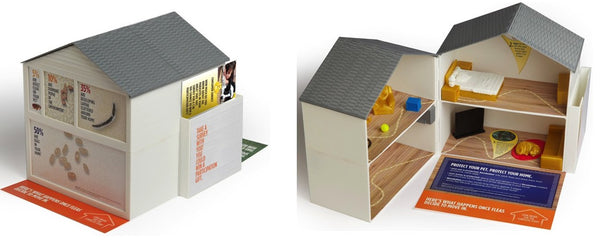In the mid-2000s, 3D printing became a buzzword, picking up press and recognized by tech fans for its seemingly limitless opportunities. But for many, the high price tag associated with the tech machine pushed would-be 3D printing hobbyists out of the market.
Driven by her curiosity and interest in trying 3D printing for themselves, one Montreal woman decided to change that, opening the first dedicated 3D printing and 3D scanning retail store in Canada.MatterThingsopened in 2013, offering both 3D printing and design services to everyone from beginners to master designers.
Founder Claudia Schmidt had been interested in 3D printing for years. After returning to Canada following a seven-year stint working in aviation in Dubai, she decided to turn their fascination into a business.
“When [my husband and I] came back to Canada, he said hey, remember when I read about 3D printing? That’s when the hype of 3D printing was just starting,” says Schmidt.
She bought the first machine, a used model, for $2,500 and began floating around the idea to acquaintances to see if there would be any interest. After tinkering and learning the methods of 3D printing, she listed 3D printing services on Kijiji and started to get more and more orders coming in with requests to design and to produce 3D-printed materials. At the time, it was only one machine and a completely home-based operation.
The Face-to-Face Factor

The concept of printing a physical object from a machine known for printing on paper was a foreign concept to many Canadians.
At that time, nobody knew what the machines were,” says Schmidt.
With few options for 3D printing services in Montreal — and at the time across North America — the emails quickly began flowing in as a response to the classified ad.
“What was happening was that people were so curious about how these machines work that they wanted to see how they worked.”
“It was like a tourist attraction almost, they were so curious,” says Schmidt.
With frequent customer visits to theirhome business, MatterThings moved its headquarters to a retail store in a shopping mall down the street from Schmidt’s home in September 2014. The intent was to show how 3D printing works and what customers could do with it by displaying samples.
The in-person experience also offered Schmidt the opportunity to educate visitors about 3D printing and explain the printing process and pricing. At the time, many people had yet to see 3D printing in person and in action, so the questions kept rolling in.
“We spent so many hours that first year explaining how 3D printing works,” says Schmidt. Soon, the operation grew from one machine to 30, with nearly all machines running in full operation at once.
Educating customers about 3D printing increased business and also helped build relationships that turned curious browsers into return customers. Schmidt was on hand to answer any and all questions while also supervising the operation at work. While the printers generally run smoothly on their own once they get going, they are always supervised in case the filament gets clogged or in case someone touches the machine.
The visual element of seeing the machines working, many with supports — like scaffolding, says Schmidt — to keep the printing operation on schedule was a sight to be seen by many. Curiosity about the operation and physically seeing the 3D printing in action also drove foot traffic from the mall to the store.
“Definitely, there were companies that had 3D printers and that were using them already, and we had discovered there were some around the world, but in Canada, we actually were the first. Of course, there are some more shops now. At that time, it just happened to be that we were the first retail shop and in a mall,” says Schmidt.
The heightened interest in 3D printing led Schmidt torent a second locationwithin an architectural firm in downtown Montreal in March 2017 to test and see if they would attract more walk-in clients in the downtown region. But by that point, MatterThings had built such a strong clientele from the original store that the majority of the orders were coming in online through repeat customers.
Adapting to their clientele, who were now knowledgeable about the process of 3D printing, Schmidt closed both the retail space at the end of 2017 and their second office in early 2018. Schmidt now has a small studio on the West Island of Montreal to occasionally meet clients to discuss projects and see samples.
Dedicated Service

MatterThings has won over serious clients because of its reputation for excellent customer service. Printing everything from functional machine components, prosthetic hands, parts for a Mars Rover and even a rocket payload, the range for 3D printing is broad. Their clients include top Canadian university McGill, Hydro Quebec, and the Montreal Aviation Museum.
For many clients, 3D printing has offered a solution to complex problems.
“We have been doing some parts for the Montreal aviation museum and they are restoring old planes from WWI and WWII. So, of course, as you can imagine a lot of these planes were in crash sites so there were obviously some parts that were lost along the way so we are building the parts to restore these planes for the museum,” says Schmidt.
除了找到这些创新的溶胶utions in the form of 3D printed materials, MatterThings works around the clock to get projects done.
As many business owners know, you work a lot more than if you are an employee and we are basically working around the clock.
"For all of our customers, well most of them anyways, [the order] needed to be done yesterday. So, the world that we live in now is really fast so we have to be fast and that requires an overnight production as well so sometimes we are up until 4 a.m. to make that delivery,” says Schmidt.
She gives the example of a project for a big repeat customer who was working on a prototype for their own client. The company had sent them the project the day before in the afternoon and needed it delivered within less than 48 hours. This particular client is a repeat customer largely because MatterThings works to tight deadlines.
“It is definitely that we get a lot of repeat customers who come back because of the customer service,” says Schmidt.
Customer satisfaction is obviously a top priority and a factor in MatterThing’s success, with close to 250 five star reviews across Facebook, Google, industry site 3D hubs, and the MatterThings website. In many of the reviews, dedication to getting the project done on time and under time constraints, along with an excellent product, is called out by happy customers.
FURTHER READING:Learn how to turn your own customers into repeat buyers with our tips onboosting customer lifetime value.
How Reviews Have Bolstered Their Business
With a rating of 4.9 stars on Google+, MatterThings has prioritized reviews to boost its search engine optimization. The reviews also offer honest feedback to a business now reliant on ecommerce sales and marketing.
“For us, reviews are very important because they are very honest — they will tell you the good and the bad. So, we have had many customers who were coming in because they say look at this business with all the positive reviews,” says Schmidt.
As a small business, Schmidt is reliant on apps to help save time. MatterThings uses an app calledFollow Up Emailto automate reviews and experiment with wait times between the completion of a project and sending a request for a review.
Initially sending out the email one week following completion, Schmidt switched to two days following the end of a project as response rates were significantly higher. As a business based in a bilingual country with a high population of French-speaking Canadians, the couple also rely on the appLangifyto help translate their webpages.
“What is so nice now is all the apps. There is so much variety out there. We have been exploring more and more,” says Schmidt.
Making Content Marketing Work for 3D Printing Services

While working in Dubai, Schmidt took a social media masterclass which has helped with the marketing of MatterThings. While she says that not everyone needs to be a social media expert, one lesson from her class resonated with her.
“One of the things my teacher said is that not everybody is on Facebook or has a Twitter profile, but almost everyone has an email. Still, the best way to reach people is through a newsletter,” says Schmidt.
To keep in touch with their clients and offer new ideas for potential projects, MatterThings sends out a newsletter once a month to its database. These newsletters feature recent projects, industry news, and news about the business itself.
Schmidt monitors the success of the newsletter by looking into the newsletter’s open rate and monitoring what links people are clicking. By analyzing these metrics, she determines what to include in future newsletters.
“Of course video is always the top, so we try to incorporate video whenever we can,” she says.
For other entrepreneurs trying to create a strong newsletter, Schmidt suggests that business owners just be themselves and show off the personality of their business.
“In our case, we try to show people that we are not here to sell you something. We are here to show you what you can do with this technology because it is pretty amazing. You can do anything,” she says. “Keep the newsletter clean, keep it simple, and show your personality.”
除了通讯,MatterThings也blogsabout the industry and unique projects on its website. These posts are often then dispersed to their social media channels — they are currently on Facebook, Twitter, Pinterest, YouTube, and Google+.
Schmidt says she tries to blog as much as possible, with positive feedback coming in about the variety of projects from a special order of trophies used for the China Canada Film Festival last year or about the WWII plane restoration project for the Montreal Aviation Museum. The projects highlighted could also be more niche, as was the case with a part created for a for a farmer who was having serious problems with seeding his crops. MatterThings created a sort of filter to better control the seed resulting in a better season.
“It sounds like a small problem, but it is a big problem for a farmer. So, we could really be writing about anything,” says Schmidt. “Basically, the idea of the blog is to show people that the ideas could be from small to big, it doesn’t really matter. It is to show what you can do with 3D printing. It is not very sales pitchy. In the footer, it might be that we sell 3D printer services and the plastic for the 3D printers, but our main thing is the story.”
Clearly talented storytellers, Schmidt has secured a clientele by educating customers about 3D printing, first in person through their retail spaces and now through their content marketing. By adapting their business to mirror the changes in knowledge about 3D printing, they have been able to successfully retain and grow their clientele.
Ready to start your own retail business? Get started with sourcing your own products to sell >

